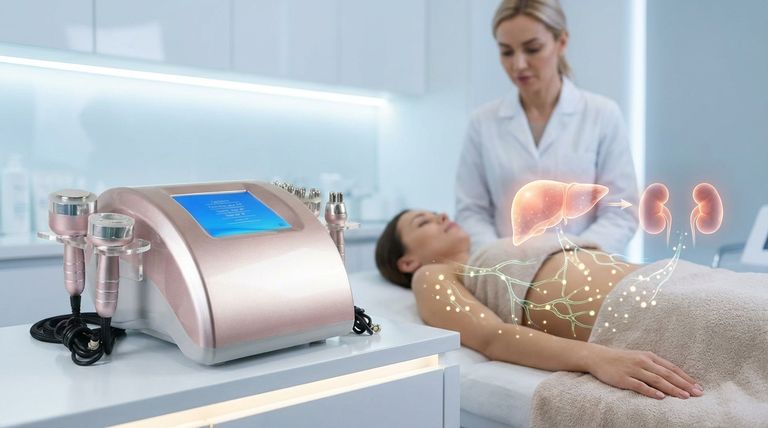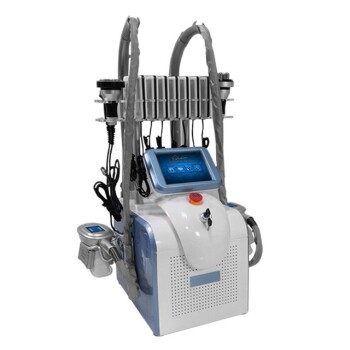After an ultrasonic cavitation treatment, the released fat is not instantly removed from your body. Instead, the contents of the ruptured fat cells are transported to your liver, where they are metabolized and prepared for elimination through your body's natural waste-clearing pathways.
Ultrasonic cavitation doesn't make fat vanish; it simply unlocks it from storage. Your body’s lymphatic system and liver then perform the crucial work of processing this released energy and filtering out the waste.

The Step-by-Step Metabolic Journey
To understand where the fat goes, it's essential to trace its path from the targeted tissue to its final exit from the body. This is a multi-step metabolic process managed by your own internal systems.
Step 1: Fat Cell Disruption
The procedure uses low-frequency ultrasound waves to create intense vibrations within the fatty tissue. This pressure, known as the "cavitational effect," causes the membrane of the fat cells (adipocytes) to break apart.
Step 2: Release of Contents
Once the fat cell membrane is compromised, its contents are released into the space between your cells, known as the interstitial fluid. This released substance is primarily composed of triglycerides.
Step 3: Transport via the Lymphatic System
Your body's lymphatic system, a network responsible for clearing waste and excess fluid, picks up the liquefied triglycerides. It acts as the primary transportation route, slowly moving this fatty substance towards processing centers.
Step 4: Processing in the Liver
The lymphatic system ultimately drains toward the liver, which is the body's primary metabolic filter. The liver does not distinguish between fat from a cavitation treatment and fat from your last meal.
Here, enzymes break down the triglycerides into two core components: glycerol and free fatty acids.
Step 5: Use or Elimination
The final destination of these components depends on your body's immediate needs:
- Glycerol is water-soluble and is transported to the kidneys, where it can be excreted in urine or converted by the liver into glucose for energy.
- Free Fatty Acids are treated as an energy source. They are either used by your muscles and organs for fuel or, if an energy surplus exists, they can be transported back to and stored in other remaining fat cells.
Understanding the Critical Factors
The success of this natural elimination process isn't guaranteed. It relies entirely on how well your body is prepared to handle the sudden release of fatty acids.
Your Liver's Health is Paramount
A healthy, functioning liver is non-negotiable for this process to work. The treatment places a metabolic demand on the liver, and its ability to efficiently process the released fat is crucial for seeing results.
The Importance of Hydration
Drinking plenty of water is essential. Adequate hydration supports optimal kidney function for excreting waste byproducts (like glycerol) and helps the lymphatic system move the fatty liquid more efficiently.
Why Post-Treatment Exercise is Recommended
Engaging in light cardiovascular activity after a session creates an immediate energy demand. This encourages your body to use the newly released free fatty acids as fuel rather than simply finding a new place to store them. Without this energy demand, the fat is likely to be redeposited.
Making the Right Choice for Your Goal
Understanding this process allows you to actively support your body to achieve the best possible outcome from the treatment.
- If your primary focus is effective elimination: Prioritize exceptional hydration before and after your session to support your lymphatic and renal systems.
- If your primary focus is preventing fat re-storage: Perform at least 20-30 minutes of light cardio within a few hours of treatment to burn the released free fatty acids.
- If your primary focus is long-term contouring: Adopt a balanced diet and consistent exercise routine, as cavitation only empties existing fat cells and does not prevent new fat storage.
By supporting your body's natural metabolic functions, you take an active role in the success of the procedure.
Summary Table:
| Stage | Key Action | Key Organ/System Involved |
|---|---|---|
| 1. Disruption | Ultrasound waves rupture fat cell membranes. | Targeted Fat Tissue |
| 2. Release | Triglycerides (fat contents) are released. | Interstitial Fluid |
| 3. Transport | Lymphatic system moves liquefied fat. | Lymphatic System |
| 4. Processing | Liver breaks down triglycerides into glycerol & fatty acids. | Liver |
| 5. Elimination/Use | Components are excreted or used for energy. | Kidneys, Muscles |
Ready to achieve superior body contouring results?
Understanding the science is the first step. Partnering with the right technology is the next. BELIS specializes in professional medical aesthetic equipment, including advanced cavitation systems designed for safety, efficacy, and outstanding patient outcomes.
Whether you run a medical aesthetics clinic or a premium beauty salon, our technology empowers you to deliver proven treatments while your clients benefit from a clear understanding of the process.
Contact BELIS today to explore our range of professional equipment and learn how we can help enhance your service offerings and grow your business.
Visual Guide

Related Products
- Ultrasonic Cavitation Radiofrecuency Machine for Body Slimming
- Cryolipolysis Fat Freezing Machine and Ultrasonic Cavitation Device
- Cryolipolysis Cavitation Machine Fat Cavitation Machine
- Cryolipolysis Fat Freezing Machine Ultrasonic Cavitation Fat Reducing Device
- EMSlim RG Laser Body Sculpting and Slimming Machine
People Also Ask
- Where does fat go after cavitation? Understand the Journey from Cell to Elimination
- What are the negative side effects of cavitation? Understanding the Risks for Your Practice
- Does cavitation get rid of belly fat? Yes, Here's How It Works for Body Sculpting
- What are the restrictions for cavitation? Ensure Your Safety and Treatment Success
- Does ultrasound really break down fat? Discover the Science of Non-Invasive Fat Reduction



















